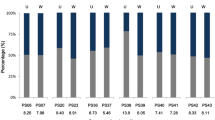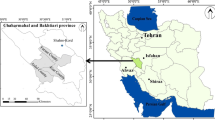Abstract
In the present study, mercury was selected because of its toxicity. It was detected in the grapevines exposed to mine gallery waters. The potential health risk of mercury in leaves of grapevine those are consumed by human worldwide was investigated. The grapevines were harvested and separated into organs of roots, stems, and leaves. The concentrations of mercury were determined in roots, stems, and leaves. The translocation and bioconcentration factors were calculated. Maximum concentrations of mercury were stem < root < leaf. The health risk potential of mercury on human health was calculated. The estimated daily exposure doses of mercury followed an order for children and adults: dietary > ingestion > inhalation > dermal. The HQ values calculated for exposure ways of dietary, ingestion and inhalation were male < female < children. As a result, it was determined that grapevine exposed to mine gallery waters that cause environmental contamination may cause non-carcinogenic risks on human health.



Similar content being viewed by others
References
Acosta-Lizárraga LG, Bergés-Tiznado ME, Bojórquez-Sánchez C, Osuna-Martínez CC, Páez-Osuna F (2020) Bioaccumulation of mercury and selenium in tissues of the mesopelagic fish Pacific hake (Merluccius productus) from the northern Gulf of California and the risk assessment on human health. Chemosphere 255, 126941
Agbeshie AA, Adjei R, Anokye J, Banunle A (2020) Municipal waste dumpsite: impact on soil properties and heavy metal concentrations, Sunyani, Ghana. Sci Afr 8, e00390
Ali MHH, Al-Qahtani KM (2012) Assessment of some heavy metals in vegetables, cereals and fruits in Saudi Arabian markets. Egypt J Aquat Res 38(1):31–37
Bal HSG, Kaplan E, Kaplan K (2019) Bağcılık ve Salamura Yaprak Konusunda Çiftçi Yönelimi ve Değerlendirmeleri (Tokat İli Pazar İlçe Örneği), Uluslararası UNİDOKAP Karadeniz Sempozyumu, 21-23 Haziran 2019 (in Turkish)
Cao P, Fujimori T, Juhasz A, Takaoka M, Oshita K (2020) Bioaccessibility and human health risk assessment of metal(loid)s in soil from an e-waste open burning site in Agbogbloshie, Accra, Ghana. Chemosphere 240, 124909
Chen CW, Chen CF, Dong CD (2012) Distribution and accumulation of mercury in sediments of Kaohsiung River Mouth, Taiwan. APCBEE Proc 1:153–158
Ciesielski T, Pastukhov MV, Szefer P, Jenssen BM (2010) Bioaccumulation of mercury in the pelagic food chain of the Lake Baikal. Chemosphere 78(11):1378–1384
Colle C, Madoz-Escande C, Leclerc E (2009) Foliar transfer into the biosphere: review of translocation factors to cereal grains. J Environ Radioact 100(9):683–689
de Oliveira LM, Das S, da Silva EB, Gao P, Gress J, Liu YG, Ma LQ (2018) Metal concentrations in traditional and herbal teas and their potential risks to human health. Sci Total Environ 633:649–657
Du B, Zhou J, Zhou L, Fan X, Zhou J (2019) Mercury distribution in the foliage and soil profiles of a subtropical forest: process for mercury retention in soils. J Geochem Explor 205, 106337
García-Rico L, Leyva-Perez J, Jara-Marini ME (2007) Content and daily intake of copper, zinc, lead, cadmium, and mercury from dietary supplements in Mexico. Food Chem Toxicol 45(9):1599–1605
Hegazy AK, Abdel-Ghani NT, El-Chaghaby GA (2011) Phytoremediation of industrial wastewater potentiality by Typha domingensis. Int J Environ Sci Technol 8(3):639–648
Ho YB, Abdullah NH, Hamsan H, Tan ESS (2017) Mercury contamination in facial skin lightening creams and its health risks to user. Regul Toxicol Pharmacol 88:72–76
Jaishankar M, Tseten T, Anbalagan N, Mathew BB, Beeregowda KN (2014) Toxicity, mechanism and health effects of some heavy metals. Interdiscip Toxicol 7(2):60–72
Jędruch A, Bełdowska M, Kwasigroch U (2019) Forms of mercury in the Baltic mussel (Mytilus trossulus): human and ecosystem health risk assessment. Environ Res 179, 108755
Kalender L, Hanelçi Ş (2001) Mineralogical and Geochemical Features of Au, Ag, Pb, Zn Mineralizations in Keban (Elazığ) Wastes. Geol Bull Turk 44(2):91–104
Khan F, Momtaz S, Abdollahi M (2019) The relationship between mercury exposure and epigenetic alterations regarding human health, risk assessment and diagnostic strategies. J Trace Elem Med Biol 52:37–47
Kumari S, Amit R, Jamwal R, Mishra N, Singh DK (2020) Recent developments in environmental mercury bioremediation and its toxicity: a review. Environ Nanotechnol Monit Manag 13, 100283
Lian M, Wang J, Sun L, Xu Z, Tang J, Yan J, Zeng X (2019) Profiles and potential health risks of heavy metals in soil and crops from the watershed of Xi River in Northeast China. Ecotoxicol Environ Saf 169:442–448
Lima A, Pereira JA, Baraldi I, Malheiro R (2017) Cooking impact in color, pigments and volatile composition of grapevine leaves (Vitis vinifera L. var. Malvasia Fina and Touriga Franca). Food Chem 22115:1197–1205
Okour AM, Alzein E, Saadeh R, Alfaqih M (2020) Food safety knowledge among Jordanians: a national study. Food Control 114, 107216
RWPC (2009) Regulation on water pollution control: sampling and analysis method. Official Gazette dated 10.10.2009 and numbered 27372
Sat IG, Sengul M, Keles F (2002) Use of grape leaves in canned food. Pak J Nutr 1:257–262
Shaheen N, Irfan NM, Khan IN, Islam S, Islam MS, Ahmed MK (2016) Presence of heavy metals in fruits and vegetables: health risk implications in Bangladesh. Chemosphere 152:431–438
Sierra MJ, Rodríguez-Alonso J, Millán R (2012) Impact of the lavender rhizosphere on the mercury uptake in the field. Chemosphere 89:1457–1466
Sipter E, Rózsa E, Gruiz K, Tátrai E, Morvai V (2008) Site-specific risk assessment in contaminated vegetable gardens. Chemosphere 71(7):1301–1307
Teixeira A, Baenas N, Dominguez-Perles R, Barros A, Rosa E, Moreno DA, Garcia-Viguera C (2014) Natural bioactive compounds from winery by-products as health promoters: a review. Int J Mol Sci 15:15638–15678
USEPA (1989) Risk assessment guidance for Superfund Human health evaluation manual, (part A) [R], vol 1, Office of Emergency and Remedial Response, Washington, DC [EPA/540/1-89/002]
USEPA (2001) Supplemental guidance for developing soil screening levels for superfund sites [R]. Office of Solid Waste and Emergency Response, Washington, DC [OSWER9355.4e24]
USEPA (2011) United States Environmental Protection Agency. Exposure Factors Handbook. National Center for Environmental Assessment. Washington, DC (EPA/600/R-09/052F). https://cfpub.epa.gov/ncea/risk/recordisplay.cfm?deid=236252
Wang Q, Li Z, Feng X, Li X, Wang D, Sun G, Peng H (2020) Vegetable Houttuynia cordata Thunb. as an important human mercury exposure route in Kaiyang county, Guizhou province, SW China. Ecotoxicol Environ Saf 197, 110575
Wei J, Cen K (2020) Assessment of human health risk based on characteristics of potential toxic elements (PTEs) contents in foods sold in Beijing, China. Sci Total Environ 70310, 134747
WHO (2015) World Health Organization, Food Safety: What you should know. http://www.searo.who.int/entity/world_health_day/2015/whd-what-you-should-know/en/#targetText=Food%20safety%20is%20about%20producing,organic%20or%20locally%20produced%20food%3F
Xia J, Wang J, Zhang L, Anderson CWN, Wang X, Zhang H, Dai Z, Feng X (2020) Screening of native low mercury accumulation crops in a mercury-polluted mining region: agricultural planning to manage mercury risk in farming communities. J Clean Prod 262, 121324
Zhang L, Wong MH (2007) Environmental mercury contamination in China: sources and impacts. Environ Int 33:108–121
Zhang J, Yang R, Li YC, Peng Y, Wen X, Ni X (2020) Distribution, accumulation, and potential risks of heavy metals in soil and tea leaves from geologically different plantations. Ecotoxicol Environ Saf 195, 110475
Author information
Authors and Affiliations
Corresponding author
Additional information
Publisher's Note
Springer Nature remains neutral with regard to jurisdictional claims in published maps and institutional affiliations.
Rights and permissions
About this article
Cite this article
Topal, M. Investigation of the potential human health risk of toxic mercury determined in the grapevine exposed to mine gallery waters. J Food Sci Technol 58, 1604–1610 (2021). https://doi.org/10.1007/s13197-020-04673-2
Revised:
Accepted:
Published:
Issue Date:
DOI: https://doi.org/10.1007/s13197-020-04673-2




